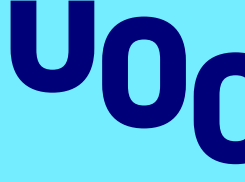An interview with the co-founder of Immersium Studio, the UOC spin-off developing virtual, augmented and mixed reality for the cultural, education, health and tourism sectors
Luis Villarejo has helped bring a triceratops to life in a museum and let people immerse themselves in the excavation of a cave in Castelldefels as they help bring the remains of elephants and rhinos from hundreds of thousands of years ago to light. These projects were made possible thanks to a spin-off emerging from the UOC's activities a year ago and developed by Villarejo, a computer engineer and expert in natural language processing. He had been working for over a decade in the field of educational technology before the know-how and experience gained in augmented, virtual and mixed reality – together known as immersive technology – led to the creation of Immersium Studio. The project also received support from the #SpinUOC programme. #SpinUOC fosters entrepreneurship and applications for this year's programme are currently open.
What is Immersium Studio?
Immersium Studio is a UOC spin-off where we work to create virtual and augmented reality experiences, especially for education, culture and tourism. Virtual reality is technology where you are immersed in entirely new surroundings, and can experience new sensations and role play.
What benefits does being a spin-off bring you?
The main benefits are the agility and flexibility we have to provide our services to other companies, while being under the auspices of the University, which provides us with an environment, a potential for networking and a profile that prove crucial when entering the market.
What are the main projects you are working on?
They deal with immersive learning. We're collaborating with UOC Corporate to build training experiences using virtual reality as a way to transport people to settings that are relevant to their learning, and develop activities to acquire skills. We also work in the cultural sector, creating experiences for museums to enrich visitors' experiences at exhibitions. For example, we can develop applications that allow them to aim their mobile phone at a shelf and leaf through the books.
What does it mean to have won a top prize at an international conference?
We were awarded the top prize for best product showcase at this year's Annual International Conference of the Immersive Learning Research Network. It's the most important event of its kind and it took place in London this year. The prize means a lot to us since this is the leading immersive learning organization in the world. Winning this award is a sign that we're doing the right thing with Immersium Studio.
You’ve joined a UOC’s incubation hub: what’s that like?
It is a great opportunity for us, because it raises our profile in an environment that is really suited to what we do and because it paves the way for networking with other initiatives in our field. Coming into contact with other projects means we can take advantage of synergies, and work and grow together.
Could you recommend a work that’ll help us grasp the idea of immersive technology?
Charlie Fink's Metaverse. It’s a guide to the state of the art in immersive technologies: augmented reality, virtual reality and mixed reality. It covers the state of current research and applications in these three areas, and looks at the prospects for the future. It looks at the subject in depth, but it's worth reading because it gives a general idea of how these technologies work.
Immersium Studio has received funding from Invergy, a UOC company investing in projects in the education and tech sectors that are linked to the University's areas of activity and expertise. It has also received support from the University via the Hubbik entrepreneurship platform in its search for cofounding through ENISA, a state-owned company, linked to the Spanish Ministry of Industry, Trade and Tourism, that looks to foster viable, innovative business projects by providing loans to SMEs.

